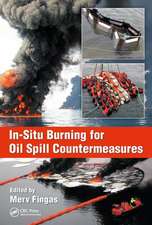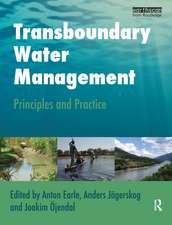Air Pollution and Freshwater Ecosystems: Sampling, Analysis, and Quality Assurance
Autor Timothy J Sullivan, Alan T. Herlihy, James R. Webben Limba Engleză Paperback – 8 iun 2018
Toate formatele și edițiile
| Toate formatele și edițiile | Preț | Express |
|---|---|---|
| Paperback (1) | 462.65 lei 6-8 săpt. | |
| CRC Press – 8 iun 2018 | 462.65 lei 6-8 săpt. | |
| Hardback (1) | 1223.80 lei 6-8 săpt. | |
| CRC Press – 20 noi 2014 | 1223.80 lei 6-8 săpt. |
Preț: 462.65 lei
Preț vechi: 544.30 lei
-15% Nou
Puncte Express: 694
Preț estimativ în valută:
88.53€ • 92.25$ • 73.30£
88.53€ • 92.25$ • 73.30£
Carte tipărită la comandă
Livrare economică 03-17 aprilie
Preluare comenzi: 021 569.72.76
Specificații
ISBN-13: 9781138747562
ISBN-10: 1138747564
Pagini: 346
Dimensiuni: 156 x 234 x 18 mm
Greutate: 0.5 kg
Ediția:1
Editura: CRC Press
Colecția CRC Press
ISBN-10: 1138747564
Pagini: 346
Dimensiuni: 156 x 234 x 18 mm
Greutate: 0.5 kg
Ediția:1
Editura: CRC Press
Colecția CRC Press
Public țintă
Academic and Professional Practice & DevelopmentCuprins
Introduction. Water Chemistry Field Sampling. Laboratory Analyses. Quality Assurance/Quality Control. Data Analysis. Field Sampling for Aquatic Biota. Transition Plan. References Cited. Appendices.
Recenzii
"… offers an original approach in dealing with atmospheric pollution, addressing key linkages between air pollution and its impact on aquatic ecosystems. …The reader who grasps the materials presented will be well equipped to design, implement, and interpret most types of water quality studies and better understand the impacts of human activities on watershed health."
—International Journal of Environmental Analytical Chemistry, 2015
"This book deserves high praise for addressing key linkages between air pollutants and their impacts on aquatic ecosystems. It is an excellent exposition of different dimensions of water pollution, its measurement and analysis. It has a wealth of information conveyed in a lucid manner for students and researchers alike."
—Dr. Hem H. Dholakia, Research Fellow, Indian Institute of Management, Ahmedabad
"The authors have each spent more than 30 years designing and implementing long-term monitoring programs and spatially extensive synoptic surveys, managing laboratories and quality assurance programs, and analyzing freshwater data for both scientific and management/policy applications. They come from the public, private, and academic sectors and bring a range of perspective that is reflected in the breadth of protocols and discussion presented in the book. This combined experience has produced a timely volume that is sure to become a popular addition to the libraries of freshwater ecologists and biogeochemists."
—Dr. Bernard J. Cosby, Group Leader Catchments and Soils, Centre for Ecology and Hydrology Environment Centre Wales, Bangor, Gwynedd, UK
"… it is indeed fortunate that these highly qualified authors are sharing their careers-worth of experience in how to design and maintain water monitoring programs and associated assessments and to underscore the importance of long-term water quality monitoring and the necessity for good program design and rigorous protocols."
—James Galloway, University of Virginia
"This thoughtful book by masters of the science should become a classic on which new and/or redesigned studies can build."
—Professor Kevin Bishop, Uppsala University, Department of Earth Sciences
"Drawing from their considerable experience coordinating large-scale sampling programs, Sullivan et al. have written a book that should serve as a first stop for any researcher, water resources professional, or student about to embark upon the monitoring of freshwater ecosystems. … with emphasis placed on the effects from atmospherically-derived acids and toxic metals, the key principles of building a successful sampling program are easily adaptable to a wide range of water quality measurement and monitoring applications."
—Todd M. Scanlon, Department of Environmental Sciences, University of Virginia
"… a self-explanatory and ideal tool for professionals, involved in water quality and watershed research, aquatic ecology, wetland biodiversity, decision and policy makers, conservation units, managerial teams (including planners, practitioners, and programmers) for designing and implementing long-standing monitoring programs, aquatic laboratory managers, government and non-government sectors, water resources professionals, academicians and students."
—Dr. Hiren B. Soni, Institute of Science & Technology for Advanced Studies & Research (ISTAR), Department of Environmental Science & Technology (EST), Vallabh Vidyanagar-388120 (Gujarat) INDIA
"… this voluminous work will undoubtedly fascinate all those who have dedicated their career in one way or the other towards understanding and managing the aquatic resources. I am sure, it will particularly interest modern fraternity involved addressing these questions of ecology and environmental sciences. Such workers will find in this volume a holistic view of knowledge that has not been previously assembled at one place. Moreover, in so doing, they will find the essential scientific basis for understanding an emerging paradigm for management of water and watershed resource."
—Professor of Environmental Science, Banaras Hindu University, India
"The authors of this book draw on their 30 years of experience designing and implementing water quality monitoring programs to create this valuable reference for freshwater ecologists and biogeochemists. They explore study design and techniques for water chemistry field sampling. They also consider laboratory procedures, quality control, data analysis and how to sample the aquatic biota. Included in the appendix are specific protocols, guidance documents and data entry forms."
—Ringgold, Inc. Book News, February 2015
—International Journal of Environmental Analytical Chemistry, 2015
"This book deserves high praise for addressing key linkages between air pollutants and their impacts on aquatic ecosystems. It is an excellent exposition of different dimensions of water pollution, its measurement and analysis. It has a wealth of information conveyed in a lucid manner for students and researchers alike."
—Dr. Hem H. Dholakia, Research Fellow, Indian Institute of Management, Ahmedabad
"The authors have each spent more than 30 years designing and implementing long-term monitoring programs and spatially extensive synoptic surveys, managing laboratories and quality assurance programs, and analyzing freshwater data for both scientific and management/policy applications. They come from the public, private, and academic sectors and bring a range of perspective that is reflected in the breadth of protocols and discussion presented in the book. This combined experience has produced a timely volume that is sure to become a popular addition to the libraries of freshwater ecologists and biogeochemists."
—Dr. Bernard J. Cosby, Group Leader Catchments and Soils, Centre for Ecology and Hydrology Environment Centre Wales, Bangor, Gwynedd, UK
"… it is indeed fortunate that these highly qualified authors are sharing their careers-worth of experience in how to design and maintain water monitoring programs and associated assessments and to underscore the importance of long-term water quality monitoring and the necessity for good program design and rigorous protocols."
—James Galloway, University of Virginia
"This thoughtful book by masters of the science should become a classic on which new and/or redesigned studies can build."
—Professor Kevin Bishop, Uppsala University, Department of Earth Sciences
"Drawing from their considerable experience coordinating large-scale sampling programs, Sullivan et al. have written a book that should serve as a first stop for any researcher, water resources professional, or student about to embark upon the monitoring of freshwater ecosystems. … with emphasis placed on the effects from atmospherically-derived acids and toxic metals, the key principles of building a successful sampling program are easily adaptable to a wide range of water quality measurement and monitoring applications."
—Todd M. Scanlon, Department of Environmental Sciences, University of Virginia
"… a self-explanatory and ideal tool for professionals, involved in water quality and watershed research, aquatic ecology, wetland biodiversity, decision and policy makers, conservation units, managerial teams (including planners, practitioners, and programmers) for designing and implementing long-standing monitoring programs, aquatic laboratory managers, government and non-government sectors, water resources professionals, academicians and students."
—Dr. Hiren B. Soni, Institute of Science & Technology for Advanced Studies & Research (ISTAR), Department of Environmental Science & Technology (EST), Vallabh Vidyanagar-388120 (Gujarat) INDIA
"… this voluminous work will undoubtedly fascinate all those who have dedicated their career in one way or the other towards understanding and managing the aquatic resources. I am sure, it will particularly interest modern fraternity involved addressing these questions of ecology and environmental sciences. Such workers will find in this volume a holistic view of knowledge that has not been previously assembled at one place. Moreover, in so doing, they will find the essential scientific basis for understanding an emerging paradigm for management of water and watershed resource."
—Professor of Environmental Science, Banaras Hindu University, India
"The authors of this book draw on their 30 years of experience designing and implementing water quality monitoring programs to create this valuable reference for freshwater ecologists and biogeochemists. They explore study design and techniques for water chemistry field sampling. They also consider laboratory procedures, quality control, data analysis and how to sample the aquatic biota. Included in the appendix are specific protocols, guidance documents and data entry forms."
—Ringgold, Inc. Book News, February 2015
Notă biografică
Dr. Timothy Sullivan holds a BA in history from Stonehill College, Easton, Massachusetts (1972); an MA in biology from Western State College, Gunnison, Colorado (1977); and a PhD in biological sciences from Oregon State University, Corvallis (1983) through an interdisciplinary program that included areas of focus in ecology, zoology, and environmental chemistry. He did his postdoctoral research at the Center for Industrial Research in Oslo, Norway, on surface and groundwater acidification, episodic hydrologic processes, and aluminum biogeochemistry. His expertise includes the effects of air pollution on aquatic and terrestrial resources, watershed analysis, critical loads, ecosystem services, nutrient cycling, aquatic acidbase chemistry, episodic processes controlling surface water chemistry, and environmental assessment. He has been president of E&S Environmental Chemistry, Inc., since 1988 and E&S Environmental Restoration, Inc., since 1996. He has served as project manager or lead author for a wide variety of projects that have synthesized for diverse audiences complex air and water pollution effects science. He was project manager of the effort to draft a scientific summary and Integrated Scientific Assessment (ISA) of the effects of nitrogen and sulfur oxides on terrestrial, transitional, and aquatic ecosystems for the US Environmental Protection Agency (EPA) in support of its review of the National Ambient Air Quality Standards (NAAQS). He was author of the National Acid Precipitation Assessment Program (NAPAP) State of Science and Technology Report on past changes in surface water acid-base chemistry throughout the United States from acidic deposition. He served as project manager for preparation of air quality reviews for national parks throughout California and coauthored similar reviews for the Pacific Northwest and the Rocky Mountain and Great Plains regions. He has summarized air pollution effects at all 272 Inventory and Monitoring national p
Descriere
A practical book for professionals who rely on water quality data for decision making, this book is based on three decades experience of three highly published water and watershed resource professionals. It focuses on the analysis of air pollution sensitive waters and the consequent effects associated with soil and water acidification, nutrient-N enrichment, or the effects of atmospherically deposited toxic substances. It also covers lake zooplankton and/or stream macroinvertebrate biomonitors. Explanations of the reasons behind various recommendations provide readers with the tools needed to alter recommended protocols to match particular study needs and budget.


























